Solanum nigrum
Solanum nigrum, the European black nightshade or simply black nightshade or blackberry nightshade,[1] is a species of flowering plant in the family Solanaceae, native to Eurasia and introduced in the Americas, Australasia, and South Africa. Ripe berries and cooked leaves of edible strains are used as food in some locales, and plant parts are used as a traditional medicine. Some other species may also be referred to as "black nightshade".[2]
| Solanum nigrum | |
|---|---|
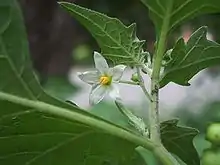 | |
| Scientific classification | |
| Kingdom: | Plantae |
| Clade: | Tracheophytes |
| Clade: | Angiosperms |
| Clade: | Eudicots |
| Clade: | Asterids |
| Order: | Solanales |
| Family: | Solanaceae |
| Genus: | Solanum |
| Species: | S. nigrum |
| Binomial name | |
| Solanum nigrum | |
| Subspecies | |
|
S. nigrum subsp. nigrum | |
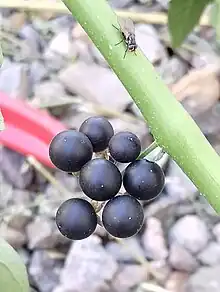
Solanum nigrum has been recorded from deposits of the Paleolithic and Mesolithic era of ancient Britain and it is suggested by the botanist and ecologist Edward Salisbury that it was part of the native flora there before Neolithic agriculture emerged.[3] The species was mentioned by Pliny the Elder in the first century AD and by the great herbalists, including Dioscorides.[4] In 1753, Carl Linnaeus described six varieties of Solanum nigrum in Species Plantarum.[5]
Description
.jpg.webp)
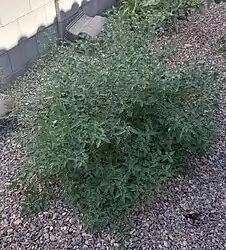
Black nightshade is a common herb or short-lived perennial shrub, found in many wooded areas, as well as disturbed habitats. It reaches a height of 30 to 120 cm (12 to 47 in), leaves 4.0 to 7.5 cm (1.6 to 3.0 in) long and 2 to 5 cm (1 to 2 in) wide; ovate to heart-shaped, with wavy or large-toothed edges; both surfaces hairy or hairless; petiole 1 to 3 cm (0.5 to 1 in) long with a winged upper portion. The flowers have petals greenish to whitish, recurved when aged and surround prominent bright yellow anthers. The berry is mostly 6 to 8 mm (0.24 to 0.31 in) in diam., dull black or purple-black.[6] In India, another strain is found with berries that turn red when ripe.[7]
Sometimes S. nigrum is confused for the more toxic deadly nightshade (Atropa belladonna), which is in a different genus within Solanaceae. A comparison of the fruit shows that the black nightshade berries grow in bunches, whereas the deadly nightshade berries grow individually. Another distinction is black nightshade flowers have white petals.
Growth habit
The suited soil pH value of black nightshade is between 5.5 and 6.5. It is rich in organic matter, water and fertility on the strong soil growth, in the lack of organic matter, poor ventilation clay, its roots will be stunted, plant growth is weak, commodity is poor. It is difficult to grow under the condition of high temperature and high humidity, the plant grows slowly, the tender shoot is easy to aging fiber, and the commodity is poor.[8]
Taxonomy
Solanum nigrum is a highly variable species with many varieties and forms described.[9] The recognized subspecies are:[4]
1. S. nigrum L. subsp. nigrum — glabrous to slightly hairy with appressed non-glandular hairs
2. S. nigrum L. subsp. schultesii (Opiz) Wessley — densely hairy with patent, glandular hairs
The Solanum nigrum complex — also known as Solanum L. section Solanum — is the group of black nightshade species characterized by their lack of prickles and stellate hairs, their white flowers, and their green or black fruits arranged in an umbelliform fashion.[9] The Solanum species in this group can be taxonomically confused, more so by intermediate forms and hybridization between the species.[4] Some of the major species within the S. nigrum complex are: S. nigrum, S. americanum, S. douglasii, S. opacum, S. ptychanthum, S. retroflexum, S. sarrachoides, S. scabrum, and S. villosum.
Toxicity

Solanine levels in S. nigrum have been tested, and the plant is rarely fatal.[10]
Solanine poisoning symptoms may occur when immature green fruit (looks similar to green peas) or mature leaves are ingested raw. They are typically delayed for 6 to 12 hours after ingestion.[11] Initial symptoms of toxicity include fever, sweating, vomiting, abdominal pain, diarrhea, confusion, and drowsiness.[12] Death from ingesting large amounts of the plant results from cardiac arrhythmias and respiratory failure.[12] Livestock have also been poisoned from nitrate toxicity by grazing the mature leaves and green berries of S. nigrum.[4] However, in central Spain, the great bustard (Otis tarda) may act as a seed disperser of European black nightshade (Solanum nigrum).[13] Black nightshade is highly variable, and some advise to avoid eating the berries unless they are a known edible strain.[14] The toxin levels may also be affected by the plant's growing conditions.[4] The toxins in S. nigrum are most concentrated in the unripe green berries, and immature fruit should be treated as toxic.[11][12][15] Most cases of suspected poisoning are due to consumption of leaves or unripe fruit. There are ethnobotanical accounts of S. nigrum young leaves and shoots being boiled as a vegetable with the cooking water being discarded and replaced several times to remove toxins.[4] Solanine is water-soluble and is destroyed by boiling.[12] S. nigrum leaves may be different from this perspective. Young cooked leaves of Solanum complex sp. are a source many useful nutrients similar to levels found in spinach.[16] Solanum complex berries have been consumed on every continent since ancient times.
Uses
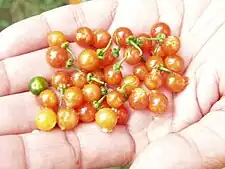
Some of the uses ascribed to S. nigrum in literature may actually apply to other black nightshade species within the same species complex, and proper species identification is essential for food and medicinal uses (See Taxonomy section).[2][9]
Culinary usage
S. nigrum has been widely used as a food since early times, and the fruit was recorded as a famine food in 15th-century China.[17] Despite toxicity issues with some forms, the ripe berries and boiled leaves of edible strains are eaten. The thoroughly boiled leaves — although strong and slightly bitter flavours — are used like spinach as horta and in fataya pies and quiches. The ripe black berries are described as sweet and salty, with hints of liquorice and melon.[18]
In Kenya, among the Abagusii, S. nigrum (rinagu - singular; amanagu - plural) is a vegetable delicacy which when blanched and sauteed or boiled to soften and then salted or sauteed and eaten with Ugali (a corn meal product). In the rest of Kenya, S. nigrum(managu) is eaten in a similar way.
In Tanzania, S. nigrum (mnafu or mnamvu in Kiswahili) is a popular green vegetable. Sautéed with chicken or pork, eaten with Ugali, it is an expensive meal in most restaurants in urban areas. Traditionally, the Iraqw people in northern Tanzania have used S. nigrum (manakw) as vegetable for generations, eaten with special ‘ugali’ (xwante), stiff porridge made with corn, millet or sorghum flour. An ethnobotanical survey conducted in the mid 1990s on the islands of Zanzibar and Pemba indicated that S. nigrum was referred to as vwevwe in Kiswahili.[19]
In India, the berries are casually grown and eaten, but not cultivated for commercial use. In South India, the leaves and berries are routinely consumed as food after cooking with tamarind, onion, and cumin seeds.[20] The berries are referred to as "fragrant tomato". Although not very popular across much of its growing region, the fruit and dish are common in Tamil Nadu (மணத்தக்காளி in Tamil), Kerala, southern Andhra Pradesh, and southern Karnataka. They are used not only fresh but also dried.
In Ethiopia, the ripe berries are picked and eaten by children. During famines, all affected people would eat berries. In addition, the leaves are collected by women and children, who cook the leaves in salty water and consume them like any other vegetable. Farmers in the Konso Special Woreda report that because S. nigrum matures before the maize is ready for harvesting, it is used as a food source until their crops are ready.[21] The Welayta people in the nearby Wolayita Zone do not weed out S. nigrum that appears in their gardens since they likewise cook and eat the leaves.[22]
In Ghana, they are called kwaansusuaa, and are used in preparing various soups and stews, including the popular palm nut soup commonly eaten with banku or fufu.[23]
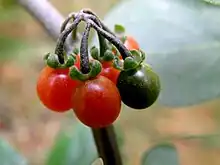
In South Africa, the very ripe and hand-selected fruit (nastergal in Afrikaans and umsobo in Zulu) is cooked into a runny purple jam.[24] However, the fruit used in South Africa is more likely to be Solanum retroflexum.[25]
In Greece and Turkey, the leaves are called istifno, and in Crete known as stifno. They are one of the ingredients included in the salad of boiled greens known as horta.[26]
In Indonesia, the young fruits and leaves of cultivated forms are used and are known as ranti (Javanese) or leunca (Sundanese). The fruit and leaves are eaten raw as part of a traditional salad lalapan, or the fruit is cooked (fried) with oncom.[27]
It was imported into Australia from Mauritius in the 1850s as a vegetable during the gold rush,[18] but S. nigrum is now prohibited for trade as a food by the Australia New Zealand Food Standards Code.[28]
During ancient times in Hawaii young shoots, leaves, small white flowers, and small black berries were eaten.[29] The leaves, among other greens, were cooked by rolling hot stones among them in a covered gourd.[30]
Medicinal usage
The plant has a long history of medicinal usage, dating back to ancient Greece. "... In the fourteenth century, we hear of the plant under the name of Petty Morel being used for canker and with Horehound and wine taken for dropsy."[31] It was a traditional European medicine used as a strong sudorific, analgesic and sedative with powerful narcotic properties, but was considered a "somewhat dangerous remedy".[31][32] Internal use has fallen out of favor in Western herbalism due to its variable chemistry and toxicity, but it is used topically as a treatment for herpes zoster.[33][34][35][36] There is much disagreement as to whether the leaves and fruit of S. nigrum are poisonous. But many countries grow this plant as a food crop. The toxicity of S. nigrum may vary by the region and species where it grows.[37] Native Hawaiians use the berries' juice as a laxative, they also take the young leaves boiled to relieve sore throats and coughs.[38]
S. nigrum is an important ingredient in traditional Indian medicines. Infusions are used in dysentery, stomach complaints, and fever.[39] The juice of the plant is used on ulcers and other skin diseases.[39] The fruits are used as a tonic, laxative, appetite stimulant, and for treating asthma and "excessive thirst".[39] Traditionally the plant was used to treat tuberculosis. This plant's leaves are used to treat mouth ulcers that happen during winter periods of Tamil Nadu, India. In North India, the boiled extracts of leaves and berries are also used to alleviate liver-related ailments, including jaundice. The juice from its roots is used against asthma and whooping cough.[40]
S. nigrum is a widely used plant in oriental medicine where it is considered to be antitumorigenic, antioxidant, anti-inflammatory, hepatoprotective, diuretic, and antipyretic.[41][42]
Some experiments indicate that the plant inhibits growth of cervical carcinoma in mice.[43] The active ingredient of the plant, solanine, inhibits the proliferation of different cancer cells in vitro, such as breast cancer and pancreatic cancer. Its anti-tumor mechanism is mainly through the induction of different cell and molecular pathways, leading to apoptosis and autophagy of cells and molecules, and inhibiting tumor metastasis.[44][45] Water extracts of Solanum nigrum have shown a citotoxic activity in reducing ROS generation of the human MM cell line A-375.[46]
Solanum nigrum is known to contain solasodine (a steroidal glycoalkaloid that can be used to make 16-DPA progenitor); a possible commercial source could be via cultivating the hairy roots of this plant.[47][48]
It is also a treatment of gastric ulcer. Through experiments on mice gastric ulcer model and control group, the results showed that the extract of black nightshade powder and methanol could significantly affect the secretion of gastric acid and protease in mice, thus significantly reducing the gastric ulcer index of mice.[49] Solanum nigrum,[46] Tasmannia pepper leaf, anise myrtle and lemon myrtle share a high concentration of polyphenols and polysaccharides, which take a role in inhibition of iNOS and COX-2 activities, resulting "a viable approach to inhibit inflammation and carcinogenesis and to prevent cancer."[50]
Uttroside B, a saponin, was identified as a bioactive chemotherapeutic agent, against hepatocellular carcinoma, obtained from the methanolic extract of S. nigrum.[51] Lankalapalli et al. isolated uttroside B and provided its structure elucidation by derivatization, which afforded an enol ether, and characterized by detailed 2D NMR analysis in this publication.[52] Uttroside B and uttroside A can be differentiated by the group present in C-22 with hydroxyl and methoxy groups, respectively. The structural resemblance of uttroside B and uttroside A poses a challenge in differentiation of these two molecules by NMR or other techniques. Recently, this group provided a correction of a NMR figure with respect to the structure of uttroside B, which enable differentiation of uttroside B from uttroside A with characteristic chemical shift difference in 13C NMR of hemiketal carbon C-22 at 110.5 and 112.5 ppm, respectively.[53] US-FDA granted an orphan drug designation for uttroside B against hepatocellular carcinoma.
Cultivation
Black nightshade is cultivated as a food crop on several continents, including Africa and North America. The leaves of cultivated strains are eaten after cooking.[18] A garden form with fruit about 1.27 cm (0.50 in) diam. is occasionally cultivated.[54]
Weed
Black nightshade can be a serious agricultural weed when it competes with crops.[55][56] It has been reported as a weed in 61 countries and 37 crops. Herbicides are used extensively to control it in field crops such as cotton.
References
- Grubb, Adam; Raser-Rowland, Annie (2012). The Weed Forager's Handbook. Australia: Hyland House Publishing Pty Ltd. p. 35. ISBN 9781864471212.
- Mohy-ud-dint, A; Khan, Z; Ahmad, M; Kashmiri, MA (2010). "Chemotaxonomic value of alkaloids in Solanum nigrum complex" (PDF). Pakistan Journal of Botany. 42 (1): 653–660.
- Salisbury, EJ (1961). Weeds and Aliens. New Naturalists Series. London: Collins.
- Edmonds, JM; Chewya, JA (1997). Black Nightshades, Solanum nigrum L. and related species. International Plant Genetic Resources Institute. ISBN 9789290433217.
- Linnaeus, C (1753). Species Plantarum IV-V.
- "Solanum nigrum plant profile". New South Wales Flora Online.
- Venkateswarlu, J; Krishna Rao, M (1971). "Inheritance of fruit colour in the Solanum nigrum complex". Proceedings of the Indian Academy of Sciences, Section B. 74 (3): 137–141. doi:10.1007/BF03050624. S2CID 80921919.
- Ogg, AG; Rouger, BS; Schiling, EE (1981). "Characterization of Black Nightshade (Solanum nigrum) and Related Species in the United States". Weed Science. 29 (1): 27–31. doi:10.1017/S0043174500025789. S2CID 182438916.
- Solanum nigrum Factsheet, South Australian Government
- North, P (1977). Poisonous Plants and Fungi in Colour. Blandford Press. pp. 140–141.
- Schep, LJ; Slaughter, RJ; Temple, WA (April 3, 2009). "Contaminant berries in frozen vegetables". The New Zealand Medical Journal. 122 (1292): 95–6. PMID 19448780. Retrieved 2 May 2017.
- "Solanum nigrum profile". IPCS. INCHEM.
- Bravo, C.; Velilla, S.; Peco, B. (2014). "Effects of Great Bustard (Otis tarda) gut passage on Black Nightshade (Solanum nigrum) seed germination". Seed Science Research. 24 (3): 265–271. doi:10.1017/S0960258514000178. hdl:10261/97149. S2CID 32739044.
- Turner, NJ; von Aderka, P (2009). The North American guide to common poisonous plants and mushrooms. Timber Press. pp. 181–182. ISBN 9780881929294.
- Tull, D (1999). Edible and Useful Plants of Texas and the Southwest— A Practical Guide. University of Texas Press. ISBN 978-0-292-78164-1.
- "Solanum nigrum Black Nightshade, Common Nightshade, Poisonberry, Black Nightshade PFAF Plant Database".
- Read, BE (1977). Famine Foods of the Chiu-Huang Pen-ts'ao. Taipei: Southern Materials Centre.
- Irving, M (2009). The Forager Handbook — A Guide to the Edible plants of Britain. Ebury Press. ISBN 978-0-09191-363-2.
- Heine, Bernd; Legère, Karsten (1995). Swahili Plants: An Ethnobotanical Survey. Cologne: Rüdiger Köppe Verlag and Köln. p. 305. ISBN 3-927620-89-0.
- Ignacimuthu, S (2006-05-11). M Ayyanar, Sankara Sivaraman K. "Ethnobotanical investigations among tribes in Madurai District of Tamil Nadu (India)". Journal of Ethnobiology and Ethnomedicine. 2: 25. doi:10.1186/1746-4269-2-25. PMC 1475842. PMID 16689985.
- ""Wild Food" Plans with "Famine Foods" Components: Solanum nigrum". Famine Food Guide.
- Zemede, Asfaw (29–31 August 1995). Conservation and use of traditional vegetables in Ethiopia. Proceedings of the IPGRI International Workshop on Genetic Resources of Traditional Vegetables in Africa. Nairobi. Archived from the original on 2012-07-07.
- Asibey-Berko, E; Tayie, FAK. "Proximate analysis of some under-utilized Ghanaian vegetables". Ghana Journal of Science. 39: 91–96.
- Jansen van Rensburg, WS; et al. (2007). "African leafy vegetables in South Africa". Water SA. 33 (3): 317–326. doi:10.4314/wsa.v33i3.180589.
- "umsobosobo, noun". Dictionary of South African English. Retrieved 9 April 2021.
- "Amaranth — vlita — and black nightshade — stifno (Βλήτα και στίφνος)". Organically Cooked. 2008. Archived from the original on 2023-01-23. Retrieved 2012-08-09.
- "Leunca/ranti". Sehat itu anugerah. 2010.
- "Standard 1.4.4 — Prohibited and Restricted Plants and Fungi". Australia New Zealand Food Standards Code. Australian Government.
- "Nā Puke Wehewehe ʻŌlelo Hawaiʻi".
- Thrum, Manoa Valley, Hawaiian Annual 1892
- Grieve, M (1984). A Modern Herbal. Penguin. pp. 582–583.
- Schauenberg, P; Paris, F (1977). Guide to Medicinal Plants. Keats Publishing Inc. p. 53.
- Nohara, T; Ikeda, T; Fujiwara, Y; Matsushita, S; et al. (2006). "Physiological functions of solanaceous and tomato steroidal glycosides". Journal of Natural Medicines. 61 (1): 1–13. doi:10.1007/s11418-006-0021-y. S2CID 36689200.
- Ikeda, T; Ando, J; Miyazono, A; Zhu, XH; et al. (March 2000). "Anti-herpes virus activity of Solanum steroidal glycosides". Biological & Pharmaceutical Bulletin. 23 (3): 363–4. doi:10.1248/bpb.23.363. PMID 10726897.
- Nohara, T; Yahara, S.; Kinjo, J (1998). "Bioactive Glycosides from Solanaceous and Leguminous Plants". Natural Product Sciences. 4 (4): 203–214.
- Schmelzer, GH, ed. (2008). PROTA: Medicinal Plants 1.
- Jimoh, F.O.; Adedapo, A.A; Afolayan, A.J. (2010). "Comparison of the Nutritional Value and Biological Activities of the Acetone, Methanol and Water Extracts of the Leaves of Solanum nigrum and Leonotis leonorus". Food and Chemical Toxicology. 48 (3): 964–71. doi:10.1016/j.fct.2010.01.007. PMID 20079394.
- Fahs, Barbara. "Healing Plants: Pōpolo - Foundation of the Hawaiian Pharmacy". Ke Ola. No. May-June 2014. Retrieved 28 October 2022.
- Jain, SK (1968). Medicinal Plants. Thomson Press (India) Ltd. pp. 133–134.
- Sikdar, M; Dutta, U (2008). "Traditional Phytotherapy among the Nath People of Assam" (PDF). Studies on Ethno-Medicine. 2 (1): 39–45. doi:10.1080/09735070.2008.11886313. S2CID 54662164.
- Jain, R; Sharma, A; Gupta, S; Sarethy, IP; Gabrani, R (Mar 2011). "Solanum nigrum: current perspectives on therapeutic properties" (PDF). Altern Med Rev. 16 (1): 78–85. PMID 21438649. Archived from the original (PDF) on 2016-07-05. Retrieved 2011-05-06.
- Gubarev, M. I.; Enioutina, E. Y; Taylor, J. L.; Visic, D. M; Daynes, R. A (1998). "Plant‐derived glycoalkaloids protect mice against lethal infection with Salmonella typhimurium". Phytotherapy Research. 12 (2): 79–88. doi:10.1002/(SICI)1099-1573(199803)12:2<79::AID-PTR192>3.0.CO;2-N. S2CID 83679181.
- Jian, L; Qingwang, L; Tao, F; Kun, L (2008). "Aqueous extract of Solanum nigrum inhibit growth of cervical carcinoma (U14) via modulating immune response of tumor bearing mice and inducing apoptosis of tumor cells". Fitoterapia. 79 (7–8): 548–556. doi:10.1016/j.fitote.2008.06.010. PMID 18687388.
- Mohsenikia, M.; Alizadeh, A. M.; Khodayari, S.; Khodayari, H.; Karimi, A. (2013). "The protective and therapeutic effects of alpha-solanine on mice breast cancer". European Journal of Pharmacology. 718 (1–3): 1–9. doi:10.1016/j.ejphar.2013.09.015. PMID 24051269.
- Lv, C.; Kong, H.; Dong, G.; Liu, L.; Tong, K.; Sun, H.; Zhou, M. (2014). "Antitumor efficacy of α-solanine against pancreatic cancer in vitro and in vivo". PLOS ONE. 9 (2): e87868. Bibcode:2014PLoSO...987868L. doi:10.1371/journal.pone.0087868. PMC 3914882. PMID 24505326.
- Binbing Ling; Deborah Michel; Meena Kishore Sakharkar; Jian Yang (2016). "Evaluating the cytotoxic effects of the water extracts of four anticancer herbs against human malignant melanoma cells". Drug Design, Development and Therapy. 10: 3563–3572. doi:10.2147/DDDT.S119214. PMC 5098531. PMID 27843296.
Based on the current results, we hypothesized that coadministration of the water extract of S. nigrum could improve the therapeutic efficacy of temozolomide, as well as DTIC, against human MM. Further studies are warranted to prove our hypothesis using a patient-derived xenograft or a mouse xenograft melanoma model.
- Wu, X. F.; Shi, H. P.; Tsang, P.; Keung, E. (2008). "Induction and in vitro culture of hairy roots of Solanum nigrum L. Var. Pauciflorum Liou and its solasodine production". Journal of Molecular Cell Biology. 41 (3): 183–91. PMID 18630597.
- Yogananth, N; Bhakyaraj, R; Chanthuru, A; Parvathi, S; Palanivel, S (Jan 2009). "Comparative Analysis of Solasodine from in vitro and in vivo cultures of Solanum nigrum Linn". Kathmandu University Journal of Science, Engineering and Technology. 5 (I): 99–103. doi:10.3126/kuset.v5i1.2850.
- Akhtar, M. S.; Munir, M. (1989). "Evaluation op the gastric antiulcerogenic effects of Solanum nigrum, Brassica oleracea and Ocimum basilicum in rats". Journal of Ethnopharmacology. 27 ((1-2)): 163–76. doi:10.1016/0378-8741(89)90088-3. PMID 2515396.
- Yu Guo; Karunrat Sakulnarmrat; Izabela Konczaka (2014). "Anti-inflammatory potential of native Australian herbs polyphenols". Toxicology Reports. 1: 385–390. doi:10.1016/j.toxrep.2014.06.011. PMC 5598408. PMID 28962255.
- Nath, Lekshmi R.; Gorantla, Jaggaiah N.; Thulasidasan, Arun Kumar T.; Vijayakurup, Vinod; Shah, Shabna; Anwer, Shabna; Joseph, Sophia M.; Antony, Jayesh; Veena, Kollery Suresh; Sundaram, Sankar; Marelli, Udaya K.; Lankalapalli, Ravi S.; Anto, Ruby John (2016). "Evaluation of uttroside B, a saponin from Solanum nigrum Linn, as a promising chemotherapeutic agent against hepatocellular carcinoma". Scientific Reports. 6: 36318. Bibcode:2016NatSR...636318N. doi:10.1038/srep36318. PMC 5093766. PMID 27808117. S2CID 4966820.
- Nath, Lekshmi R.; Gorantla, Jaggaiah N.; Thulasidasan, Arun Kumar T.; Vijayakurup, Vinod; Shah, Shabna; Anwer, Shabna; Joseph, Sophia M.; Antony, Jayesh; Veena, Kollery Suresh; Sundaram, Sankar; Marelli, Udaya K.; Lankalapalli, Ravi S.; Anto, Ruby John (2016). "Evaluation of uttroside B, a saponin from Solanum nigrum Linn, as a promising chemotherapeutic agent against hepatocellular carcinoma". Scientific Reports. 6: 36318. Bibcode:2016NatSR...636318N. doi:10.1038/srep36318. PMC 5093766. PMID 27808117. S2CID 4966820.
- Nath, Lekshmi R.; Gorantla, Jaggaiah N.; Thulasidasan, Arun Kumar T.; Vijayakurup, Vinod; Shah, Shabna; Anwer, Shabna; Joseph, Sophia M.; Antony, Jayesh; Veena, Kollery Suresh; Sundaram, Sankar; Marelli, Udaya K.; Lankalapalli, Ravi S.; Anto, Ruby John (2020). "Author Correction: Evaluation of uttroside B, a saponin from Solanum nigrum Linn, as a promising chemotherapeutic agent against hepatocellular carcinoma". Scientific Reports. 10 (1): 20431. doi:10.1038/s41598-020-77440-0. PMC 7676244. PMID 33208836. S2CID 227065139.
- "Wonderberry". Center for New Crops & Plant Products, Purdue University.
- Taab, A (2009). Seed dormancy and germination in Solanum nigrum and S. physalifolium as influenced by temperature conditions (Thesis). Swedish University of Agricultural Sciences.
- Keeley, PE; Thullen, RJ (1991). "Biology and Control of Black Nightshade (Solanum nigrum) in Cotton (Gossypium hirsutum)". Weed Technology. 5 (4): 713–722. doi:10.1017/S0890037X00033741. JSTOR 3986881. S2CID 89885270.
External links
 Media related to Solanum nigrum (category) at Wikimedia Commons
Media related to Solanum nigrum (category) at Wikimedia Commons- Solanum nigrum profile, IPCS INCHEM
- https://web.archive.org/web/20141113185306/http://foragersharvest.com/black-nightshade-2/
- http://www.dpi.nsw.gov.au/__data/assets/pdf_file/0008/112796/garden-plants-poisonous-to-people.pdf
- http://www.herbiguide.com.au/Descriptions/hg_Blackberry_Nightshade.htm